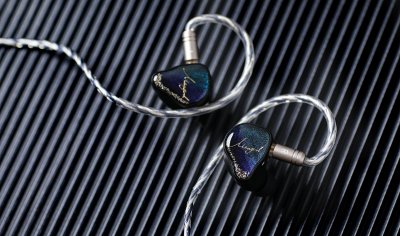Moondrop Blessing 3 and Xenns Tea Pro use 2DD+4BA and 2DD+6BA driver setups respectively. Moondrop Blessing 3 costs $320 while Xenns Tea Pro costs $359. Xenns Tea Pro is $39 more expensive. Xenns Tea Pro holds a slight 0.4-point edge in reviewer scores (7.1 vs 7.6). Xenns Tea Pro carries a user score of 8. Xenns Tea Pro has significantly better bass with a 1.3-point edge, Xenns Tea Pro has better mids with a 0.8-point edge, Xenns Tea Pro has significantly better treble with a 1-point edge, Xenns Tea Pro has slightly better soundstage with a 0.3-point edge and Xenns Tea Pro has significantly better imaging with a 1-point edge.
Insights
| Metric | Moondrop Blessing 3 | Xenns Tea Pro |
|---|---|---|
| Bass | 6.6 | 8 |
| Mids | 6.7 | 7.5 |
| Treble | 6.6 | 7.6 |
| Details | 7.2 | 7.2 |
| Soundstage | 7 | 7.3 |
| Imaging | 6.5 | 7.5 |
| Dynamics | 6 | 6 |
| Tonality | 6.6 | 7.4 |
| Technicalities | 7 | 7.2 |
Moondrop Blessing 3 Aggregated Review Score
Average Reviewer Scores
Average Reviewer Score:
7.1Generally Favorable
Xenns Tea Pro Aggregated Review Score
Average Reviewer Scores
Average Reviewer Score:
7.6Strongly Favorable
Reviews Comparison
Moondrop Blessing 3 reviewed by Z-Reviews
Youtube Video Summary
Moondrop Blessing 3 ditches the old vibe for a fresh hybrid recipe: H.O.D.D.U.S. (two horizontally opposed 10 mm dynamics) plus 4× BA at around $320. The stage isn’t huge, by design—this is an intimate, in-the-head presentation that puts the music right up front. Bass is quick, tight, and more about responsiveness than brute slam; treble is crisp without splash, and nothing feels exaggerated. The crossover is impressively cohesive—no obvious handoff between DDs and BAs—yielding a “mixing/mastering” sort of neutrality with excellent detail retrieval and control. Think subtle-but-capable: delicate when it should be, instantly punchy when it must.
Build is peak Moondrop showpiece—shiny stainless backplate, clear acrylic shell showing the guts, and a comfy fit—but the stock 3.5 mm cable is underwhelming. The box is over-engineered fun; the tips selection is one silicone type in many sizes (foam not ideal here). Tip rolling to something like Dunu S&S keeps bass honest. Amp pairing prefers clean, linear gear; warm hybrids can push mids oddly, while neutral solid-state keeps things balanced. Not hard to drive (~12 Ω). Skip if you crave gobs of soundstage; absolutely grab if the goal is a neutral, close-up, fast, and coherent listen that “force-feeds” the music—without the fatigue. A confident buy for presence and precision.
Z-Reviews Youtube Channel
Buy Moondrop Blessing 3 on Aliexpress
Ad
Price: $579
Buy Moondrop Blessing 3 on Aliexpress
Xenns Tea Pro reviewed by Z-Reviews
Youtube Video Summary
Xenns Tea Pro lands with the familiar “Tea” swagger: a baby-blue, sparkled shell that looks subdued but premium, a modular 3.5/4.4 cable that clicks together more cleanly than most, and the infamous ultra-soft pouch (yes, the “chinchilla” one). Build is hefty yet comfortable, with a tiny ear “shelf” that doesn’t poke and giant L/R markers that actually help. Inside is an 8-driver stack—2 dynamic + 6 balanced armatures—priced around $360, right in the historic Tea lane. Wide-bore tips can make the upper range shouty, but switch to foams or X-Elastic and the tuning snaps into place: smooth, powerful, and deeply satisfying.
Sonically it’s the sports car that rides like a chaise lounge: speed and detail on tap, but with the warmth dialed up ~20% so long sessions feel luxurious. Bass reaches low with a tactile rumble that sneaks up in tracks, mids are rich and present, and treble is tastefully shaved to avoid glare—energy without edge. The stage isn’t stadium-wide; instead it’s an immersive “pressed-in” bubble that places the orchestra around the head with excellent instrument presence and macro-dynamics. It carries the Tea/T2 lineage forward by focusing less on sterile “detail points” and more on excitement and physicality—music shoved into the ear in the most pleasurable way. Verdict: an unabashed 10/10 crowd-pleaser in its bracket and a default recommendation—pop on the 4.4 plug, use the right tips, and let it cook.
Z-Reviews Youtube Channel
Buy Xenns Tea Pro on Linsoul
Ad
Price: $359
Buy Xenns Tea Pro on Linsoul
Moondrop Blessing 3 reviewed by Tim Tuned
Youtube Video Summary
Moondrop Blessing 3 steps up as the most complete Blessing yet—cleaner and more controlled than the Blessing 2: Dusk, with less bass quantity but sharper dynamics and a tidier lower-midrange. It avoids the slight thinness some hear on Variations, keeping notes lean but satisfying. The midrange stays beautifully natural and a touch energetic without shout, while the biggest upgrade is in the treble: retaining the Dusk’s natural decay yet adding more air, so micro-details pop and vocals take center stage. The overall tilt is more vocal-forward and detail-focused than Dusk.
On the technical front, resolution sits around—or a notch above—the Timeless, with an impressively wide stage helped by reduced bass bleed and boosted upper air. Micro-detail is present but not laser-etched; separation could use that last half-step of incisiveness. Still, imaging, control, and clarity make for an easy “wow” on first listen, especially for listeners who value clean layering over sheer slam.
Comparisons are straightforward: versus the original Blessing 2, this is an upgrade across the board—cleaner lows, punchier bass quality, better lower-treble timbre, and comparable air. Versus Blessing 2: Dusk, choose Dusk for a more balanced and fuller bass hit; pick Blessing 3 for vocal presence, detail, and control. Against SoftEars Studio 4, Studio 4 sounds about a half-step more balanced with a touch more bass fullness and slightly better timbre, but the Blessing 3’s performance at roughly $320 is seriously competitive for the class. After a few underwhelming Moondrop releases, this feels like reclaiming the throne—a highly recommended return to form.
Tim Tuned Youtube Channel
Xenns Tea Pro reviewed by Tim Tuned
Youtube Video Summary
Xenns Tea Pro lands as an easy pick around $300 thanks to a natural, versatile tuning that blends tasteful fun with everyday usability. A gentle bass boost adds heft, slam, and definition without muddying the mids, while a touch of upper-mid lift keeps vocals clear—even on bass-heavy tracks—without tipping into thin or clinical territory. Treble stays smooth regardless of shallow or deep fit, supporting lifelike timbre and realistic decay that favors long, fatigue-free listening. Detail comes across as “natural detail” rather than etched; micro-nuances don’t jump out, but nothing feels missing or dulled either.
Against the Top Pro, bass through mids on the Top Pro can sound a bit tighter and more transparent, but its treble risks feeling overcooked and a touch “BA-like,” trading naturalness for extra sparkle and perceived detail. Tea Pro keeps the highs non-fatiguing and tonally convincing, making it the safer everyday choice. The “dream combo” would marry Top Pro’s bass-to-upper-mids with Tea Pro’s treble, but as it stands, Tea Pro remains a well-balanced, easy recommendation for its class—natural yet fun, clean vocals, and a bonus metal shell that seals the deal for all-day use.
Tim Tuned Youtube Channel
Moondrop Blessing 3 reviewed by Jaytiss
Youtube Video Summary
The Moondrop Blessing 3 is a 2DD + 4BA hybrid with a larger, premium-feeling shell that remains surprisingly comfortable—though size could be an issue for smaller ears. Accessories and build echo Moondrop’s recent releases (even the analog cable mirrors the Dusk’s), underscoring a cohesive design philosophy. Tuning skews a touch brighter and more analytical: airy upper-mids/treble, crisp detail retrieval, and clean separation, with lighter bass impact than some rivals. It’s a set that showcases “technicalities” in an immediately noticeable way.
Against the Crinacle x Moondrop Dusk, Blessing 3 trades some punch and warmth for extra sparkle and detail; Dusk offers more bass, slightly calmer treble, and a touch more “slam,” while Blessing 3 sounds airier and more incisive. Versus Variations, the graphs are similar and they trade blows, but Variations’ bass advantage struggles to justify the higher price for most listeners. Compared to Moondrop’s more affordable options (e.g., Aria 2) and value picks like TruthEar Hexa or AFUL’s Magic One, Blessing 3 delivers a more refined treble presentation and step-up resolution, while some mid-fi competitors around ~$600 don’t clearly outpace it in engagement or detail.
Priced ~$330 (often on sale around $280), Blessing 3 sits at the sweet spot before diminishing returns hit hard. The trade-offs are clear: a touch bright, bass-light for those craving heft, and not the absolute value king next to Dusk—but as an airy, detailed, well-built daily driver, it’s easy to recommend. Final call: a strong A-—especially fitting for treble-heads and anyone seeking a clean, modern Moondrop tuning without paying flagship prices.
Jaytiss Youtube Channel
Xenns Tea Pro reviewed by Jaytiss
Youtube Video Summary
The Xenns Tea Pro impresses most with its exceptional build quality and aesthetics. The metallic shell feels substantial and premium in the ear, featuring a comfortable wing design and a nice metal nozzle. While slightly larger than its predecessors like the Tea and Tea2, the Pro's shell represents an upgrade in feel and technology, boasting a prettier faceplate. The included cable is thick, braided, and features a swappable termination (4.4mm or 3.5mm), contributing to an overall solid package that feels like a significant step up from previous models.
Sonically, the Tea Pro offers a bassy but clean signature with strong, impactful low end. However, it presents some key drawbacks: the bass can feel slightly boomy or distorted rather than pristine, and the overall presentation leans dark and rich. This comes at the expense of upper treble sparkle, air, and micro-details, resulting in a narrow soundstage and less impressive instrument separation than expected at its price point. While extremely pleasant and engaging for music listening, it feels slightly muffled and lacks the clarity and detail retrieval of many competitors.
When stacked against rivals like the Dunu Da Vinci, Kiwi Ears Quintet, EM10, DUNU DaVinci, Hype 4, or CCA CA4, the Tea Pro often falls short sonically. Competitors generally offer better air, treble extension, cleaner bass, or superior detail. Its own predecessor, the Tea2, is considered more neutral and relaxed. Consequently, while the Tea Pro is a contender with its fantastic build and fun tuning, it might be skippable for those prioritizing pure sound quality. It earns a recommendation for newcomers or those valuing premium construction, but audiophiles seeking the best sound may find better options elsewhere.
Jaytiss Youtube Channel
Moondrop Blessing 3 reviewed by Jays Audio
Youtube Video Summary
Moondrop Blessing 3 brings excellent resolution, clarity, and layering, with a clean, transparent tonality that skews bright-leaning neutral. Treble is extended without being splashy, giving plenty of air to cymbals and female vocals, while the midrange stays unmasked and articulate—piano and guitar transients pop with crisp decay. Staging is open and airy with pinpoint imaging (not wrap-around holographic like the biggest stage monsters), and the bass is snappy, tight, and bleed-free. The catch: the low end sits back, so on certain tracks the presentation can feel light, and a 6 kHz rise can get spicy at louder volumes depending on the song; vocals may lean a touch thin in classic Moondrop fashion.
Compared to Blessing 2, it’s a clear step up in cleanliness, note definition, and separation. Versus Dusk, think side-grade: a slightly brighter tilt and less bass weight, trading some low-end texture/extension for more air and edge definition. The set responds very well to EQ—a ~+5 dB low shelf @ 60 Hz (Q 0.5) and about −1.5 dB @ 6 kHz (Q 3) adds punch and reins in glare; with this, it approaches Variations performance while filling in mid-bass a bit. Simple nozzle filters (e.g., Alina/Tanchjim-style) can also tame upper mids and nudge bass up. For listeners who want more slam and tamer highs, stock tuning won’t be the endgame; for those preferring a clean, airy, detail-forward neutral, Blessing 3 is pretty banging at its price and technically competitive with pricier sets (think RS5, Oracle, even EGL7M on technicals, though the latter still stages wider). If Moondrop’s house sound clicks, it’s an easy rec; if not, look at cheaper options like Hexa or keep an eye out for a potential B3 “Dusk” variant.
Jays Audio Youtube Channel
Xenns Tea Pro reviewed by Jays Audio
Youtube Video Summary
The Xenns Tea Pro stands as the most refined and well-rounded iteration of the Tea series to date, offering strong competition in the $300 IEM market. While it loses some of the unique "sauce" found in earlier models, it delivers significant improvements, particularly sounding like a "better Da Vinci" with its bass presentation. The Pro features a similar heaviness and thickness to the notes but adds more upper mids, treble extension, and overall better resolution. For roughly $60 more than the Da Vinci, the Pro offers upgraded drivers from Knowles, contributing to better timbre, a bump in technical performance, and equally good accessories.
Compared to the original Tea and Tea 2, the Pro emerges as the better all-rounder but lacks their distinct character. The original Tea remains superior for its highly addicting vocals, bite, and holographic staging, while the Pro offers more balanced, fuller, smoother, and more versatile vocals alongside superior bass in slam, texture, impact, resolution, and rumble due to its new dual dynamic drivers. Treble extension, overall resolution, and a more open stage also see noticeable improvements over both predecessors. Technical performance-wise, the Pro is highly competitive with other $200+ IEMs, offering better resolution, imaging, transience, attack, and separation than the Da Vinci, along with a more natural sound.
Positioned under $400, the Tea Pro fits as a balanced choice between neutral and exciting tunings. Against the clean, neutral Pilgrim or Dusk, the Pro provides a bassier, heavier, fuller sound with more forward vocals and better note weight. Compared to the exciting Estrella, the Pro is more balanced, thicker, and slams harder, while the Estrella offers more dynamic contrast and crispier treble. Versus the similarly priced Hype 4, the Pro delivers harder slam, deeper bass, and sharper vocals with more bite, though the Hype 4 is slightly quicker, smoother, and more balanced. Essentially, the Tea Pro excels as a versatile, resolving set with satisfying bass and well-tuned vocals, making it the best pick for most listeners despite losing some quirks of earlier models.
Jays Audio Youtube Channel
Moondrop Blessing 3 reviewed by Gizaudio Axel
Gizaudio Axel original ranking
Gizaudio Axel Youtube ChannelXenns Tea Pro reviewed by Gizaudio Axel
Gizaudio Axel original ranking
Gizaudio Axel Youtube Channel
Moondrop Blessing 3 reviewed by
 Fresh Reviews
Fresh Reviews
Youtube Video Summary
Moondrop’s Blessing 3 pushes a distinctly airy, high-clarity take on competitive audio. The stage feels a touch farther from the head, with solid imaging, depth perception, and verticality, but it walks the edge of “how far is too far” for games like Valorant and Apex. Detail retrieval up top is crisp and separation of higher-frequency cues is clean, yet the set could use a bit more immediacy and extra sub-/mid-bass to weight deep thumps and footsteps. Once ears adjust, performance is strong, though the bright tilt can be fatiguing for some. The see-through shell with a metallic faceplate is slick; accessories are fine but basic at this price ($310), with tips and cable that invite swapping.
Against Dunu’s SA6 MK2, the Blessing 3 sits on the “open/bright” end while the Dunu plays “closer/warmer,” delivering more urgency from its fuller low end—but that extra mid-bass can blur layering and separation when many similar cues trigger at once. For pure game sense, both have Wallhack Certified potential, just not near the top; sets like Kiwi Ears Orchestra Light (V2) strike a smarter middle ground with better balance for mixed scenarios, and options such as Dunu Vulkan or Raptgo Hook-X can edge them out. Ergonomics are good on both; the SA6 MK2’s “Mini Hulk” cable and swappable plugs (4.4/2.5/3.5) and generous tip spread help justify its higher tag ($579). Summary: choose Blessing 3 for a brighter, wider, cue-separating presentation; choose SA6 MK2 for a nearer, meatier hit—while the Orchestra Light V2 remains the safer, game-first recommendation.
Fresh Reviews original ranking
Fresh Reviews Youtube Channel
Xenns Tea Pro reviewed by
 Fresh Reviews
Fresh Reviews
Youtube Video Summary
Build & presentation scream premium: a matte metal alloy shell with lush green-blue fade and gold script, plus a black-silver sparkle faceplate that looks like wearable art. Ergonomics are excellent despite a slightly wider nozzle and a bit of heft, allowing long sessions without discomfort. The package impresses with a gallery-style unboxing, matching carrying case, and a silver cable with interchangeable 3.5/4.4 terminations. Under the hood: 2 dynamic drivers + 6 BAs at ~$360.
Tonally it’s a balanced, warmer-leaning set with elevated sub-bass depth, clean attack/decay, and more treble extension and sparkle than comparable sets. The stage sits a touch more intimate, but separation and layering are immaculate, and imaging locks in with precision. Mids don’t pop as forward as some peers, yet overall resolution stays high with “oodles of detail,” giving music a rich, cohesive presentation that still feels highly detailed.
For competitive play the performance is A-tier: in Apex, Valorant, and especially Call of Duty, imaging and depth perception are master-class. Gunfire comes through cleaner with less reverb; airstrikes and mortar noise get pushed back so crucial cues like footsteps, slides, and shield pops cut through. The more intimate stage aids crosshair placement and micro-positioning, while separation stays clear even in chaotic fights. Verdict: a high A- on the Wall-Hack Certified list—an excellent pick for gamers wanting warmth, sub-bass authority, and elite imaging without sacrificing musical enjoyment.
Fresh Reviews original ranking
Fresh Reviews Youtube ChannelMoondrop Blessing 3 reviewed by Head-Fi.org
Xenns Tea Pro reviewed by Head-Fi.org
Moondrop Blessing 3 (more reviews)
Moondrop Blessing 3 reviewed by Super* Review
Youtube Video Summary
Moondrop Blessing 3 sticks to the family recipe—clean, neutral, vocal-centric—while fixing the Blessing 2’s soft spot: treble extension. Cymbals finally have proper metallic sheen and decay, and the overall imaging/separation step up. Bass comes from a dual-DD setup that favors control over quantity: tight, springy, and articulate in the sub-bass without turning the set “bassy.” Vocals are outstanding for the price—transparent, textured, and front-and-center. Physically, it’s the familiar large 3D-printed acrylic shell with a slimmer ~5.7 mm nozzle for easier tip fit, glossy metal faceplates that love fingerprints, an improved but still slightly memory-prone cable, a chunky case, and lots of tips (but no Spring Tips). Price stays put at $320.
The one nitpick: a noticeable upper-bass/lower-mids scoop that trades warmth and body for clarity. With modern productions that already carry sub-bass, the presentation feels deep and precise; with leaner acoustic or classic rock, it can read a touch sterile. Versus peers: Blessing 2 is a hair warmer and fuller but less extended up top; Blessing 2 Dusk shares the mid scoop, adds more sub-bass, and keeps the older treble quirks; Soft Ears Studio 4 is similarly lean-neutral with a bigger stage but smoother BA timbre; Kiwi Ears Orchestra Light is warmer, punchier in mid-bass, and more laid-back with weaker separation. Even with the tonal quibble, this is a clear upgrade—a “nearly perfect” neutral set and an easy 5/5.
Super* Review original ranking
Super* Review Youtube ChannelMoondrop Blessing 3 reviewed by Shuwa-T
Moondrop Blessing 3 reviewed by Yifang
Youtube Video Summary
Moondrop Blessing 2:Dusk brings a rock-solid build with clear acrylic shells that show off the 1DD+4BA internals and that cheeky anime engraving. Fit skews large—big nozzles and a bulky body—so smaller ears may struggle. The included “sweat guards” are basically stickers that tend to come off with the tips, and taking these to the gym is a bad idea (moisture can cause issues). The real sin is the stock cable: thin, microphonic, and fragile—swap it immediately. On the upside, customer service/warranty is legit if something goes wrong.
Sonically, this tuning is a crowd-pleaser. The bass extends deep for a DD and slams without bleeding, the mids are the highlight—acoustic instruments and vocals sound fantastic—and the treble is clean but can push toward fatigue for sensitive listeners or on bright EDM drops. For electronic genres (hardstyle, D&B), the low-end grip is addictive; for orchestral and vocal music, it’s as close to “set and forget” as it gets. Quick fix if the top end nudges too hot on desktop: a simple EQ cut—~−4.5 dB @ 8 kHz (Q≈1)—tames the edge and lets the volume come up for extra bass satisfaction.
Technical chops are strong: resolution pops micro-details without turning clinical, soundstage width sits in the higher percentile for the price, and dynamics swing convincingly from soft to slam. Imaging is fine, but positional distance (for Valorant/CS-style footsteps) isn’t the strength—Apex/Overwatch or media use is totally fine. Net takeaway: as an everyday all-rounder for music, games, and movies around this bracket, it’s a killer pick with just two caveats—skip the stock cable and avoid sweaty workouts—or EQ the treble if sensitive.
Yifang Youtube Channel
Moondrop Blessing 3 reviewed by Precogvision
Precogvision Youtube Channel
Moondrop Blessing 3 reviewed by Nymz
Xenns Tea Pro (more reviews)
Xenns Tea Pro reviewed by Bad Guy Good Audio
Youtube Video Summary
Xenns Tea Pro lands as a confident mid-tier contender with a 2DD+6BA setup around $350–360, going head-to-head with sets like DaVinci, Estrella, and Dusk. Sub-bass has real grunt—808 drops, the 38 Hz hit on Big Boi’s “Kill Jill,” and early-2000s hip-hop cues slam with authority yet stay controlled. Electric-bass lines have clean pluck and release, avoiding mid-bass bloom, so the low end never muddies male or female vocals; the tuning plots close to a favored target without sounding sterile.
The midrange keeps vocals center and natural—no husky haze from mid-bass, no shout from upper-mids—and treble carries harmonics without tizzy edge, handling tricky voices (think Neil Young, Elton John, Jim Croce) with ease. Fans of the Moondrop Variations’ leaner, drier 3 kHz-pushed profile may find the Tea Pro richer and less “etched,” but that extra body reads as musical rather than bloated. Crucially, the BAs avoid that metallic tinge, giving cymbals and keys a clean, pleasing sheen.
On balance, this is the kind of tuning that competes directly with its peers—and depending on priorities, arguably beats them. With punchy sub-bass, stable mids, smooth but detailed top end, and zero fatiguing quirks, the Tea Pro sits between a firm “would buy” and a potential “shameless hype” slot—prime material for renewed top-five shortlists now that the market has cooled.
Bad Guy Good Audio original ranking
Bad Guy Good Audio Youtube ChannelXenns Tea Pro reviewed by Paul Wasabii
Youtube Video Summary
XENNS Mangird Tea Pro delivers a relaxed, shallow U-shape that prioritizes balance and long-term listenability. The graph is only part of the story; what stands out is how the tuning, driver choice, and level control work together, yielding uncommon coherence for the price. Pinna gain is tastefully lowered, treble is conservative, and the set embodies a warm, smooth house sound without sacrificing clarity.
The dual 8 mm dynamic drivers keep sub-bass and mid-bass in proper ratio, so hits have body and impact without bloat; venting and shelf height sit just under the showy 10 dB many chase, which is why the bass feels tight and controlled even on bass-forward tracks. Treble stays pleasant and free of peaks or sibilance, encouraging generous volume without glare; detail is present but never pushed, so treble fans and detail kings may want more extension and bite.
The mids are the recipe for success: a darker background and restrained bass energy reveal excellent vocal enunciation and articulation, with clean note definition from the balanced armatures. Imaging and stage benefit as the bass image sits lower and slightly behind, opening a clear center for instruments; with more power the set becomes a genuine volume-scaling beast, maintaining balance as levels rise. At around $360, it reads as a refined, musical hybrid that competes confidently with recent releases while avoiding the common sub-bass heavy missteps.
Paul Wasabii Youtube Channel
Xenns Tea Pro reviewed by Audionotions
Xenns Tea Pro reviewed by Web Search
The Xenns Mangird Tea Pro offers a bass response that emphasizes sub-bass depth with a noticeable +3dB lift at 20Hz, providing substantial rumble without overwhelming the mid-bass. This allows bass guitars and electronic textures to feel tactile and controlled, while the midrange retains warmth and naturalism, particularly for male vocals and acoustic instruments. Some listeners might detect slight BA timbre in upper mids with certain female vocals or woodwind passages, though overall tonality remains engaging and rich .
Treble presentation is smooth and non-fatiguing, with adequate sparkle for cymbal decays and micro-details, though absolute air and extension fall short of EST-equipped competitors. Soundstage width leans intimate, prioritizing precise imaging and separation over vast spaciousness, while the aluminum/resin shells offer durability but may challenge smaller ears for long-term fit. The included modular cable provides termination flexibility but draws criticism for its stiffness and ergonomics .
Moondrop Blessing 3 Details
Driver Configuration: 2DD+4BA
Tuning Type: Neutral
Brand: Moondrop Top Moondrop IEMs
Price (Msrp): $320
Support our free service! Buying through our affiliate links costs you nothing extra:
Xenns Tea Pro Details
Driver Configuration: 2DD+6BA
Tuning Type: Neutral, Warm
Brand: XENNS Top XENNS IEMs
Price (Msrp): $359
Support our free service! Buying through our affiliate links costs you nothing extra:
Moondrop Blessing 3 User Review Score
Average User Scores
Average User Score: n/a
Based on 0 user reviews
No user reviews yet. Be the first one who writes a review!
Xenns Tea Pro User Review Score
Average User Scores
Average User Score:
Based on 1 user reviews
8Very Positive
Moondrop Blessing 3 Gaming Score

Gaming Score & Grade
- The gaming score is prioritizing technical capabilities of the IEM (Separation, Layering, Soundstage) and good value.
Gaming Score
6.6Gaming Grade
B+Xenns Tea Pro Gaming Score

Gaming Score & Grade
- The gaming score is prioritizing technical capabilities of the IEM (Separation, Layering, Soundstage) and good value.
Gaming Score
8Gaming Grade
A+Moondrop Blessing 3 Scorings
Average Technical & Tuning Grades
Average Tunign Grade
B+- Expect a friendly tonal balance that could use polish but remains inviting. Great for casual listening, less so for purists.
Average Technical Grade
A-- Overall technicalities are acceptable, delivering enough clarity for casual sessions. Imaging is serviceable though not immersive.
Xenns Tea Pro Scorings
Average Technical & Tuning Grades
Average Tunign Grade
A-- Tuning lands in a pleasing sweet spot with mostly coherent frequency integration. Tonality stays consistent from track to track.
Average Technical Grade
A-- The presentation feels orderly, balancing workable detail retrieval with acceptable imaging cues. It keeps momentum without smearing transients.
Moondrop Blessing 3 User Reviews
"This is an example review"
Pros
- Example pro 1
- Example pro 2
Cons
- Example con 1
- Example con 2
Share your experience and build your personal ranking list.
You need to be signed in to write your own reviewXenns Tea Pro User Reviews
Share your experience and build your personal ranking list.
You need to be signed in to write your own reviewA great IEM that punches above its price with strong technical ability and tonal balance.
Pros
Balanced and engaging signature with excellent imaging and bass texture.Cons
Treble may be slightly fatiguing to sensitive ears.Find your next IEM:
IEM Finder Quiz
newIEM Comparison Tool
newVS


































